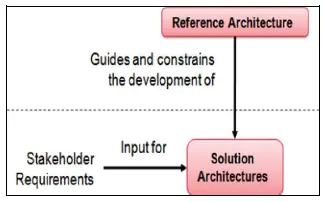 A Reference Architecture guides and constrains the development of Solution Architectures. There may be multiple Reference Architectures within a subject area where each represents a different emphasis or viewpoint. They can be defined at many levels of detail and abstraction (from specific to generalized) and for many different purposes. They help provide: [1]
A Reference Architecture guides and constrains the development of Solution Architectures. There may be multiple Reference Architectures within a subject area where each represents a different emphasis or viewpoint. They can be defined at many levels of detail and abstraction (from specific to generalized) and for many different purposes. They help provide: [1]
- A common language for the various stakeholders
- Consistency of implementation of technology to solve problems
- Support for the validation of solutions against a proven Reference Architecture
- Adherence to common standards, specifications, and patterns
The DoD Definition: “Reference Architecture is an authoritative source of information about a specific subject area that guides and constrains the instantiations of multiple architectures and solutions.”
The DoD Architecture Framework (DoDAF) defines a Solution Architecture as a framework or structure that portrays the relationships among all the elements of something that answers a problem. It describes the fundamental organization of a system, embodied in its components, their relationships with each other and the environment, and the principles governing its design and evolution.
The DoD-wide Reference Architecture is part of the DoD Enterprise Architecture (EA). It provides information, guidance, and direction that is applicable across the DoD. This information, guidance, and direction are provided in the five (5) elements that comprise a DoD-wide Reference Architecture. [1]
- Strategic Purpose: Identifies goals and objectives of the Reference Architecture and describes the specific purpose of and the problem(s) to be addressed by the Reference Architecture.
- Principles: Sufficient high-level foundational statements of rules, culture, and values that drive technical positions and patterns.
- Technical Positions: Technical guidance and standards, based on specified principles that need to be followed and implemented as part of the solution.
- Patterns (Templates): Generalized architecture representations (viewpoints, graphical/textual models, diagrams, etc.) that show relationships between elements and artifacts specified by the technical positions.
- Vocabulary: Acronyms, terms, and definitions that are used in the Reference Architecture and relevant to architectures and solutions that are guided and constrained by the Reference Architecture.
AcqLinks and References:
Updated: 7/19/2021
Rank: G12.7
